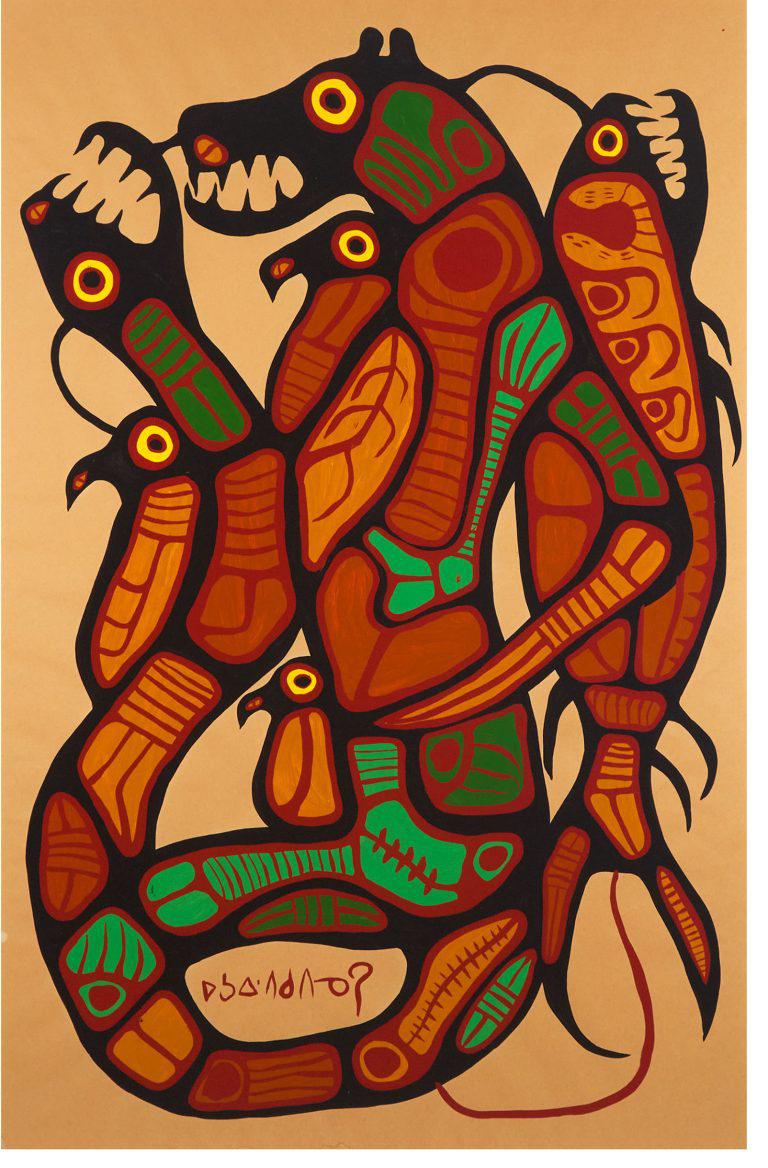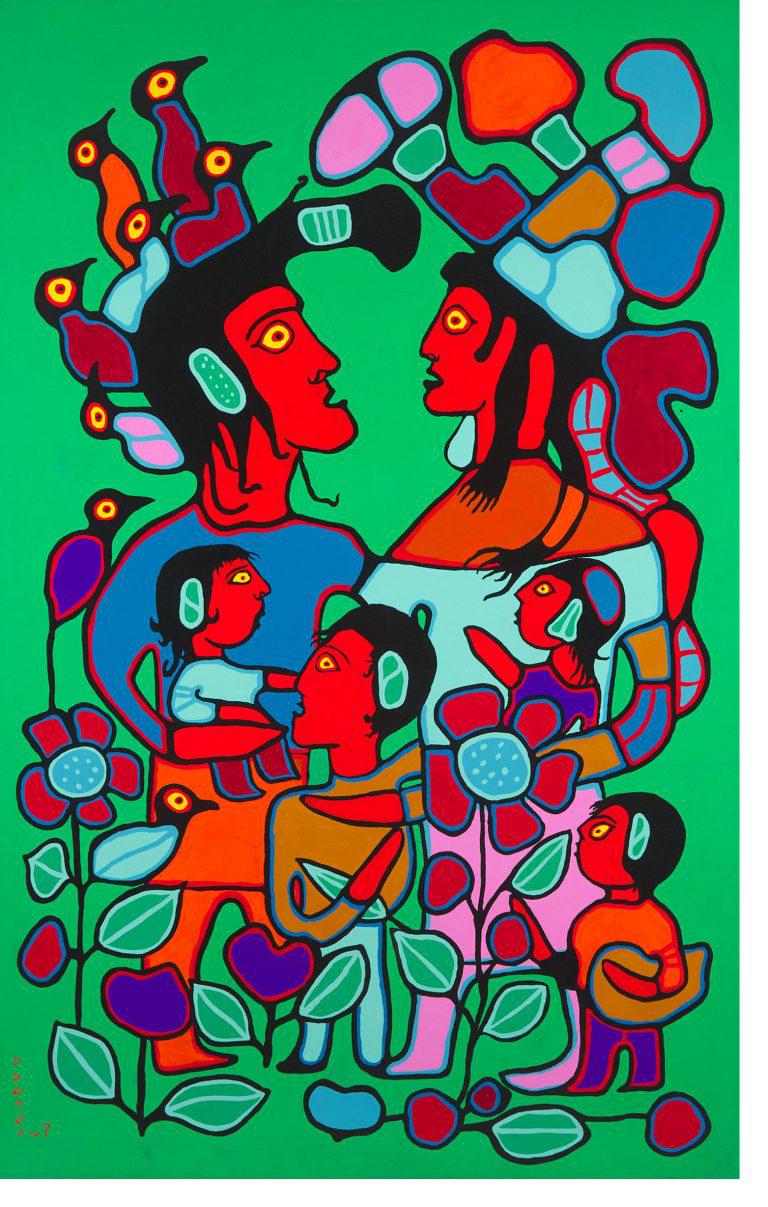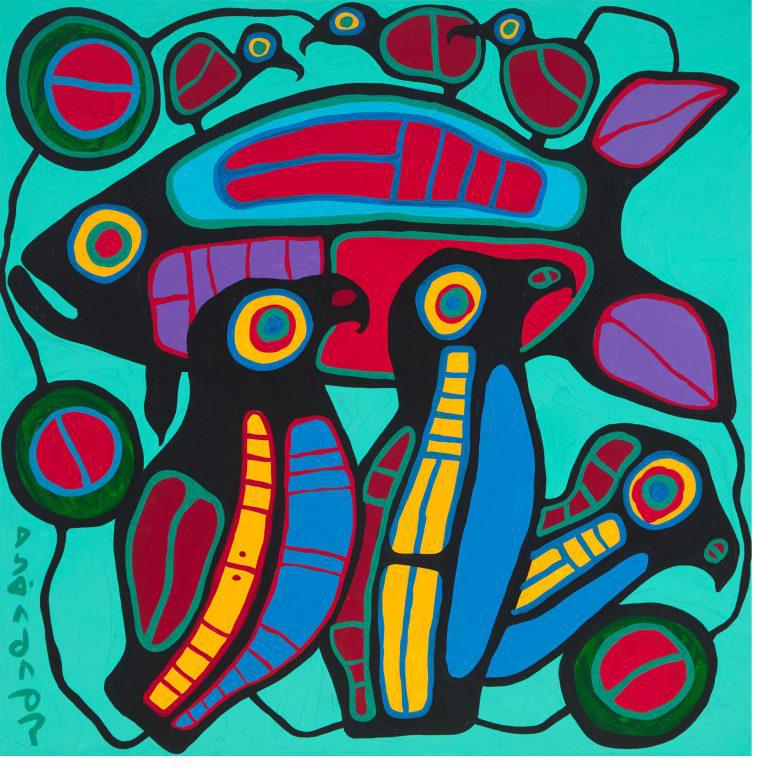
NATURE’S BALANCE, 1975
Nature’s Balance, 1975 is well-known to both scholars and collectors of work by Norval Morrisseau. It masterfully articulates the artist’s connection to nature and the interconnectedness of all life forms. The sacred bear figure in the centre is connected by bolded black outlines to the serpent, fish and three surrounding birds. Often referred to by the artist as lines of communication, these lines form closed loops and united ties between the figures.
Jack Pollock and Lister Sinclair discuss Nature’s Balance, describing the work as an “abstract composition which integrates the creatures of the sky, the earth and the waters. Strong lines of communication unite the three domains, suggesting the natural interdependence of all creatures and the environmental interactions necessary for their survival.”[1]
Nature’s Balance is one of the last paintings Morrisseau produced before his involvement with the spiritual movement, Eckankar. Morrisseau was introduced to the movement by Jack Pollock’s assistant Eva Quan in the mid-1970s. The artist drew inspiration in his work from the Eckankar teachings, as paintings from this period are often bolder and brighter in colour than his earlier work.[2]
OJIBWA FAMILY MOTIF WITH TREE OF KNOWLEDGE, 1991 AND FISH AND FOWL FORMS – COMPOSITION, 1990
Paintings by Morrisseau from this period are characterised by new, brighter colours. Already in the mid-1970s Morrisseau was introducing new colours to his paintings, drawing inspiration from his involvement with the spiritual movement Eckankar, and combining this doctrine with the Anishinaabe and Christian beliefs featured in his earlier works. By the early 1990s his signature palette of copper, yellow and blue was fully realised and “conveyed the clarity of vision, lightness, and spirituality that Eckankar espouses.”[3]

Jack Pollock and Lister Sinclair discuss the artist’s bright colour palette and the meaning and intentionality of the blue tones found in his canvases, stating that, “to Morrisseau, blue was often regarded as symbolising spiritual protection, […] the light blue indicating that the artist’s spirit is being guarded by day, whereas the mid blue means that it is being guarded by night. In a sense, these two colours seem to perform for him some of the guardian functions which, he tells us, belong to the totem spirits.”[4]
Light and dark shades of blue can be found in both Ojibwa Family Motif with Tree of Knowledge and Fish Fowl Forms – Composition. In Ojibwa Family Motif with Tree of Knowledge, Morrisseau achieves a striking sense of balance in this composition by mirroring the shades of blue in the clothing of the family. The Ojibwa family and the transference of knowledge is a recurring theme in Morrisseau’s paintings of this period.[5]
Fish Fowl Forms – Composition brilliantly depicts Morrisseau’s use of lines: a seminal aspect of Morrisseau’s Woodland School of Art style. Often referred to by the artist as lines of communication, these lines form closed loops and united ties between the figures. Morrisseau would also incorporate internal lines to depict the inner structures of animals and humans, which is apparent in the bird and fish figures in this work. Finally, the divided circle is a common motif that Morrisseau used throughout his career and can be seen in paintings as early as the 1950s. Scholar Carmen Robertson refers to the divided circle as the dualities that exist in the artist’s view of the world.[6]

ABOUT THE AUCTION
Held online from May 24-29, 2024, our spring auction of Canadian and International Fine Artbrings together exceptional work from around the world. This auction features celebrated Canadian artists such as Cornelius Krieghoff, A.Y. Jackson, P.C. Sheppard, A.J. Casson, Bertram Booker, Alexandra Luke, Jean Paul Lemieux and Yves Gaucher as well as important First Nations artists Norval Morrisseau, Roy Thomas and Alex Janvier. International highlights include work by Jules Olitski, Karel Appel, Kwon Young-Woo, Norman Bluhm, Józef Bakoś, Léon Lhermitte and Montague Dawson.
Previews will be available at our Toronto gallery, located at 275 King Street East, Second Floor, Toronto:
Thursday, May 23 from 10:00 am to 5:00 pm
Friday, May 24 from 10:00 am to 5:00 pm
Saturday, May 25 from 12:00 pm to 4:00 pm
Sunday, May 26 from 12:00 pm to 4:00 pm
Monday, May 27 from 10:00 am to 5:00 pm
Tuesday, May 28 from 10:00 am to 5:00 pm
Or by appointment.
Please contact us to find out more.
[1] Lister Sinclair and Jack Pollock, Art of Norval Morrisseau. (Toronto: Methuen, Toronto, 1979), 114.
[2] Art Canada Institute, Norval Morrisseau. Art Canada Institute, accessed 15 April 2024. https://www.aci-iac.ca/art-books/norval-morrisseau/style-and-technique/
[3] Art Canada Institute, Norval Morrisseau, Life and Works by Carmen Robertson, Art Canada Institute, accessed 15 April 2024, https://www.aci-iac.ca/art-books/norval-morrisseau/style-and-technique/.
[4] Lister Sinclair and Jack Pollock, Art of Norval Morrisseau, (Toronto: Methuen, 1979), 58.
[5] Norval Morrisseau: Honouring First Nations, (Toronto: Kinsman Robinson Galleries, 1994, Exh. Cat), 8.
[6] https://www.aci-iac.ca/art-books/norval-morrisseau/style-and-technique/


